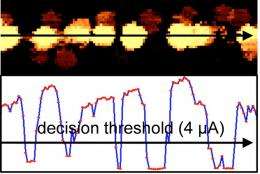This image shows mark-length recorded bits with the corresponding current below. Image credit: Wright, et al. ©2010 American Institute of Physics.
(PhysOrg.com) -- Researchers have proposed a new strategy for writing data for scanned-probe memories with user densities that are potentially more than twice as high as those achieved with conventional approaches. While previous research has shown that scanned-probe memories have the potential to achieve storage densities of up to 4 Tbit/in2, the new study shows how the density could be increased to 10 Tbit/in2 or more.
The researchers, David Wright, et al., from the University of Exeter in Devon, England, and the IBM Zurich Research Laboratory in Rueschlikon, Switzerland, have published their study on the new write strategy in a recent issue of Applied Physics Letters.
“We have shown that we can get ultra-high densities without the need for ultra-sharp tips,” Wright told PhysOrg.com. “Note that 'conventional' storage technologies like magnetic hard disk drives are currently 'stuck' at just under 1 Tbit/in2 densities and their road map does not predict reaching 10 Tbit/in2 until 2015 in the lab and 2020 for production.”
As the researchers explain, the conventional method of writing for scanned-probe memories involves writing tiny marks with a probe, and recording the data in these marks. In this method, the tip size of the probe determines the size of the recorded mark, which limits the density. An alternative write strategy is mark-length recording, in which information is stored in the transitions between the marks rather than in the marks themselves. One of the advantages of mark-length recording is that it doesn't rely as heavily on the sharpness of the probe tip as the conventional mark-position recording approach.
“The key was realizing and demonstrating that continuous scanning (which is very bad for tip wear) is not needed to implement a mark-length scheme,” Wright explained.
This is because mark-length recording can use one of the disadvantages of mark-position recording to its advantage: intersymbol interference. In the mark-position approach, bits written too close to each other can interfere with each other, so a minimum distance between bits is needed, which limits the achievable density. However, in mark-length recording, this interference can be exploited to merge marks together to make longer marks without the need for continuous tip scanning.
Although mark-length recording has already been known to increase the storage density in traditional memory systems, such as magnetic and optical disk storage, scanned-probe memories have typically used only mark-position writing. Here, the researchers demonstrate how mark-length recording can be used in scanned-probe memories, as well. In the experiment, a voltage is applied between the probe tip and a phase-change medium, which heats and activates the phase-change layer. The medium can be read by sensing the change in electrical resistivity of the written medium.
As the researchers explain, a direct comparison of the densities using these two approaches is not straightforward, but the new approach should increase the user density by at least 50%. By making further improvements, such as using sharper probe tips and ultrasmooth writing surfaces, the researchers predict that much higher densities can be achieved.
The work is part of a large EU-funded project called Probe-based Terabyte Memories (ProTeM) (http://www.protem-fp6.org), which involves the development of scanned probe storage materials and techniques for ultra-high density, ultra-low power, small form-factor archival, and back-up memories.
“Organizations and individuals are storing ever-increasing amounts of data and want to store it reliably, with low power consumption, and ideally in a small physical format,” Wright said. “The goal of our work is doing this with probe storage systems.”
More information: C.D. Wright, et al. “Write strategies for multiterabit per square inch scanned-probe phase-change memories.” Applied Physics Letters 97, 173104 (2010). DOI:10.1063/1.3506584
Copyright 2010 PhysOrg.com.
All rights reserved. This material may not be published, broadcast, rewritten or redistributed in whole or part without the express written permission of PhysOrg.com.




















